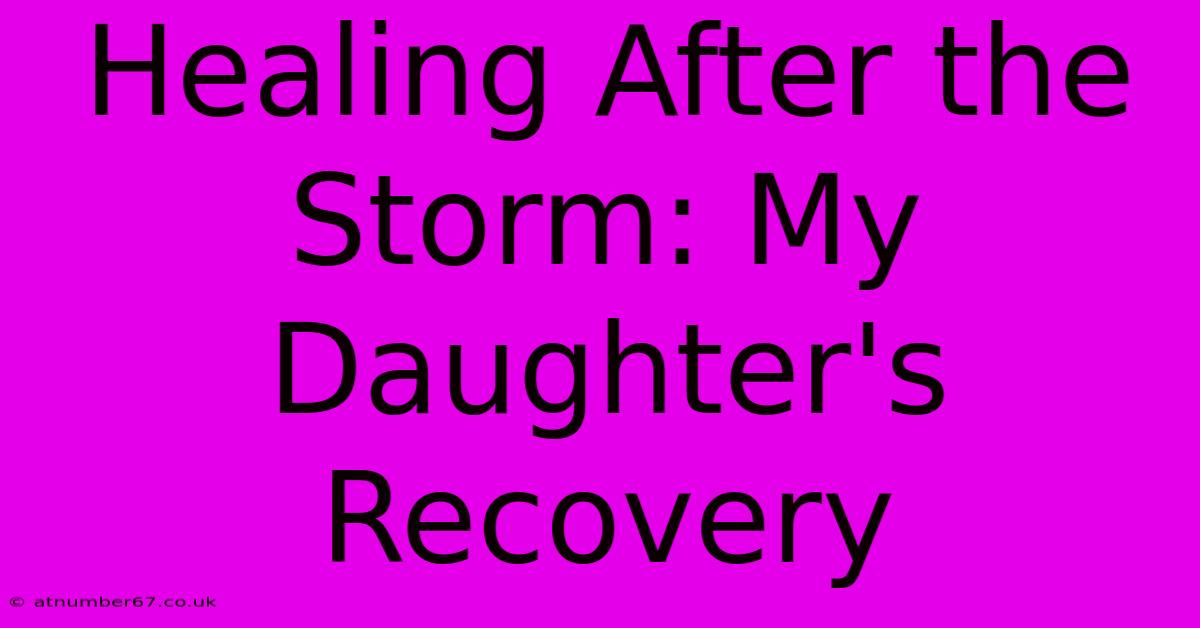Healing After The Storm: My Daughter's Recovery

Table of Contents
Healing After the Storm: My Daughter's Recovery
The storm hit hard. Not a literal hurricane, but a tempest of anxiety and depression that swept through my daughter's life, leaving a trail of devastation in its wake. This isn't a story about blame or fault, but about resilience, recovery, and the unwavering love that binds a family together. It’s a story about healing after the storm.
Understanding the Darkness
My daughter, Sarah (I'm using a pseudonym to protect her privacy), is a bright, intelligent young woman. But beneath the surface, a silent struggle was brewing. The initial signs were subtle: withdrawal, changes in appetite, difficulty sleeping. We dismissed them as teenage angst, the typical ups and downs of adolescence. However, the "downs" became increasingly frequent and intense, culminating in a breakdown that forced us to confront the harsh reality of her mental health battle.
Recognizing the Symptoms: A Parent's Guide
Looking back, there were clear warning signs we should have recognized sooner. While every individual experiences mental illness differently, some common indicators include:
- Significant changes in mood: Persistent sadness, irritability, or extreme mood swings.
- Changes in sleep patterns: Insomnia, excessive sleeping, or disrupted sleep cycles.
- Changes in appetite: Loss of appetite or significant weight changes.
- Withdrawal from social activities: Isolation and a lack of interest in previously enjoyed activities.
- Difficulty concentrating: Problems with focus, memory, and decision-making.
- Loss of interest or pleasure: Apathy and a lack of enthusiasm for things that once brought joy.
- Unexplained physical symptoms: Headaches, stomach aches, or other physical complaints.
If you notice these symptoms in your child or loved one, it's crucial to seek professional help. Early intervention is key to successful recovery.
The Journey to Healing: A Multifaceted Approach
Sarah's recovery wasn't a linear path; it was a winding road filled with challenges and breakthroughs. We embarked on a journey that involved a combination of therapies and unwavering support:
Therapy: The Cornerstone of Recovery
Therapy played a pivotal role in Sarah's healing process. She worked with a therapist specializing in adolescent mental health who provided a safe space for her to express her feelings and develop coping mechanisms. Cognitive Behavioral Therapy (CBT) proved particularly effective in helping her challenge negative thought patterns and develop healthier ways of thinking.
Medication: A Necessary Tool
In addition to therapy, medication was prescribed to help manage Sarah's symptoms. Finding the right medication took time and adjustments, but it significantly improved her mood and overall well-being. It's important to remember that medication is not a cure-all, but a valuable tool in managing mental illness.
Family Support: The Unsung Hero
Our family's unwavering support was crucial throughout this journey. We learned to communicate openly and honestly, creating a safe and supportive environment where Sarah felt comfortable sharing her struggles without judgment. Family therapy sessions helped us improve communication and learn how to best support each other.
The Light at the End of the Tunnel: Hope and Recovery
It hasn't been easy, but we are witnessing the light at the end of the tunnel. Sarah is now doing remarkably well. She's actively involved in her recovery, attending therapy regularly, and diligently managing her medications. She's reconnected with her friends, rediscovered her passions, and is looking forward to the future with renewed hope.
Lessons Learned: A Path Forward
This experience has taught us invaluable lessons about mental health, the importance of early intervention, and the power of family support. We've learned that mental illness is not a sign of weakness, but a medical condition that requires treatment and understanding. We've also learned the importance of self-care, not just for Sarah, but for our entire family.
If you're facing a similar situation, please remember you are not alone. Seek professional help, surround yourself with supportive loved ones, and never give up hope. Healing is possible.
Resources and Further Information:
While I cannot provide specific links, I strongly encourage you to search online for resources related to adolescent mental health, including organizations dedicated to providing support and information. Your doctor or therapist can also provide valuable referrals and guidance. Remember, seeking help is a sign of strength, not weakness. The path to healing after the storm is paved with support, understanding, and unwavering hope.

Thank you for visiting our website wich cover about Healing After The Storm: My Daughter's Recovery. We hope the information provided has been useful to you. Feel free to contact us if you have any questions or need further assistance. See you next time and dont miss to bookmark.
Featured Posts
-
The Creative Father And Son Crossword
Apr 15, 2025
-
Fixing Problems Building Relationships
Apr 15, 2025
-
Secret Age Of Empires 3 Hile Revealed
Apr 15, 2025
-
Alex Pereiras Net Worth Comparing Him To Other Ufc Stars
Apr 15, 2025
-
The Key To Understanding Political Systems
Apr 15, 2025
